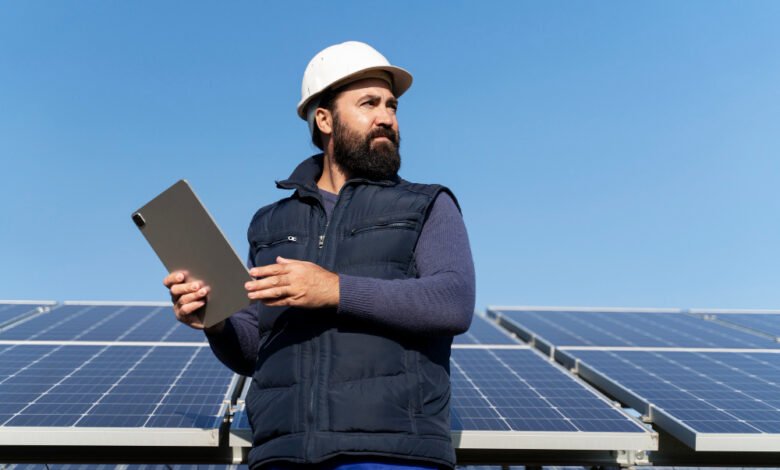Going Solar in the Desert: Challenges and Solutions
Expert Guidance from a Dubai Solar Consultant

Embarking on the journey to harness solar energy in desert landscapes like Dubai and Saudi Arabia presents a unique set of challenges and opportunities. As these regions strive towards sustainability, leveraging the abundant sunlight becomes imperative. However, navigating the complexities of desert solar installations demands expert guidance. A Dubai Solar Consultant offers invaluable insights into overcoming obstacles and maximizing the potential of solar energy in these arid environments. From optimizing panel efficiency to mitigating environmental factors like dust and sandstorms, expert consultation plays a pivotal role in realizing the promise of solar energy in desert regions.
Harnessing Abundant Sunlight
Harnessing abundant sunlight in desert regions like Dubai and Saudi Arabia presents a remarkable opportunity for sustainable energy generation. With an abundance of sunlight throughout the year, these areas possess immense potential for solar energy production. However, to fully capitalize on this resource, it’s crucial to employ advanced solar technologies and strategic panel placement techniques. Overcoming initial challenges such as dust accumulation and panel efficiency optimization requires expertise and innovation. A comprehensive approach to harnessing sunlight ensures maximum energy yield and contributes significantly to the renewable energy landscape.
Capitalizing on Solar Potential
Desert regions boast abundant sunlight, offering a promising foundation for solar energy projects. However, optimizing solar panel efficiency and mitigating dust accumulation pose initial hurdles.
Advanced Solar Technologies
A Solar Consultant in Dubai can recommend cutting-edge solar technologies tailored to desert climates. From dust-resistant solar panels in Dubai to innovative tracking systems, these solutions maximize energy generation while minimizing maintenance requirements.
Strategic Panel Placement
Expert guidance ensures optimal panel placement to capture maximum sunlight throughout the day. By leveraging precise positioning and tilt angles, solar arrays can achieve peak performance even in harsh desert conditions.
Overcoming Environmental Challenges
Desert environments pose unique environmental challenges to solar energy installations. Dust and sandstorms can diminish panel efficiency and longevity if not addressed effectively. Innovative solutions such as anti-soiling coatings and temperature management systems mitigate these risks. Moreover, managing water scarcity and implementing sustainable cleaning practices are paramount to environmental stewardship in desert regions. By addressing these challenges head-on, solar projects can thrive in harsh desert climates while minimizing their ecological footprint. Overcoming environmental challenges not only ensures the resilience of solar installations but also underscores the commitment to sustainable energy practices.
Dust and Sandstorms
Desert environments are prone to dust and sandstorms, which can diminish solar panel efficiency. Through proactive measures such as regular cleaning schedules and anti-soiling coatings, solar installations remain resilient against environmental challenges.
Temperature Management
High temperatures prevalent in desert regions can impact solar panel performance and longevity. Innovative cooling solutions, including passive ventilation and active cooling technologies, help maintain optimal operating temperatures and enhance system reliability.
Water Scarcity Considerations
Traditional cleaning methods may not be sustainable in water-scarce desert environments. Implementing water-efficient cleaning techniques and exploring alternative cleaning solutions minimize water usage while preserving solar panel effectiveness.
Regulatory and Financial Considerations
Navigating the regulatory and financial landscape is essential for the successful implementation of solar projects in Dubai and Saudi Arabia. Government incentives, including subsidies and tax credits, play a pivotal role in promoting solar energy adoption. Understanding regulatory frameworks and leveraging available incentives optimize project economics and viability. Financial considerations, such as upfront costs and return on investment, require thorough analysis and strategic planning. Engaging stakeholders and building community support are integral aspects of navigating regulatory and financial considerations. By addressing these aspects comprehensively, solar initiatives can flourish, driving sustainable development and contributing to Saudi Arabia’s sustainability objectives.
Government Incentives
Governments in Dubai and Saudi Arabia offer various incentives to promote solar energy adoption, including subsidies, tax credits, and favourable financing options. A Solar Consultant in Dubai can navigate the regulatory landscape and identify available incentives to optimize project economics.
Financial Viability
Assessing the financial feasibility of solar projects requires a comprehensive analysis of upfront costs, long-term savings, and return on investment. Expert guidance enables stakeholders to make informed decisions and secure financing options tailored to their needs.
Community Engagement
Building support and awareness within local communities is integral to the success of solar initiatives. A Solar Consultant in Dubai facilitates stakeholder engagement through education campaigns, public consultations, and community-driven sustainability programs.
Conclusion
In conclusion, transitioning to solar energy in desert regions like Dubai and Saudi Arabia demands a multifaceted approach encompassing technological innovation, environmental stewardship, and strategic planning. With guidance from a knowledgeable Solar Consultant in Dubai, stakeholders can navigate challenges, capitalize on opportunities, and accelerate the transition to a sustainable energy future, ensuring the advancement of Saudi Arabia Sustainability goals.


